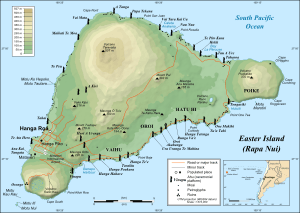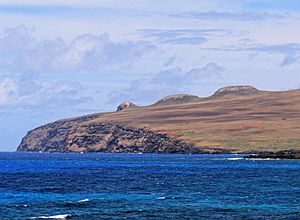Poike facts for kids

Poike is one of three large, extinct volcanoes that helped create Rapa Nui, a special island belonging to Chile in the Pacific Ocean. Standing 370 meters (about 1,214 feet) above the sea, Poike's peak is the second-highest point on the island. Only the extinct volcano Terevaka is taller.
Poike forms the eastern tip of Rapa Nui. There's a steep cliff, sometimes called the "Poike ditch," that stretches across the island. This cliff marks where the lava flows from Poike and Terevaka met long ago. Poike is the oldest of the island's three main volcanoes. Because it's so old, its rocks have worn down over time, creating soil that doesn't have many stones.
What is Poike?
Poike is a type of volcano called a shield volcano. Imagine a warrior's shield lying on the ground – that's how these volcanoes look! They have gentle slopes because the lava that flowed from them was very runny. Poike is also an extinct volcano, which means it hasn't erupted for a very, very long time and scientists don't expect it to erupt again. It played a big part in forming the land of Easter Island.
Poike's Location on Easter Island
Poike is found on the eastern side of Rapa Nui, making up one of the island's three main points. The island itself is shaped roughly like a triangle, with a volcano at each corner. Poike is at the eastern corner. The "Poike ditch" is a natural boundary between Poike and the central part of the island, which was formed by the Terevaka volcano.
How Old is Poike?
Poike is the oldest of the three main volcanoes on Easter Island. Over millions of years, wind, rain, and other natural forces have slowly broken down its rocks. This process is called weathering. Because Poike has been weathering for so long, its soil is different from other parts of the island. It has fewer stones and is often described as a richer, stoneless soil. This shows how much time has passed since Poike was an active volcano.
See also
 In Spanish: Volcán Poike para niños
In Spanish: Volcán Poike para niños
- List of volcanoes in Chile
- List of volcanoes in Pacific Ocean


